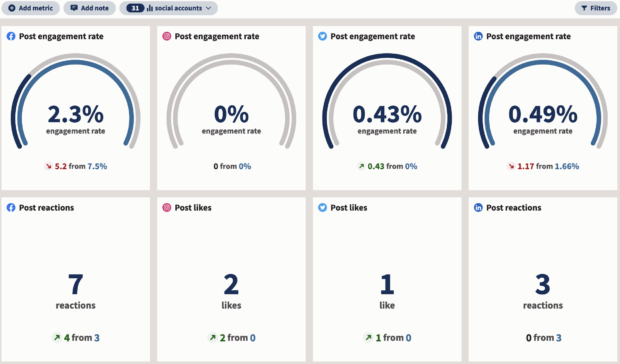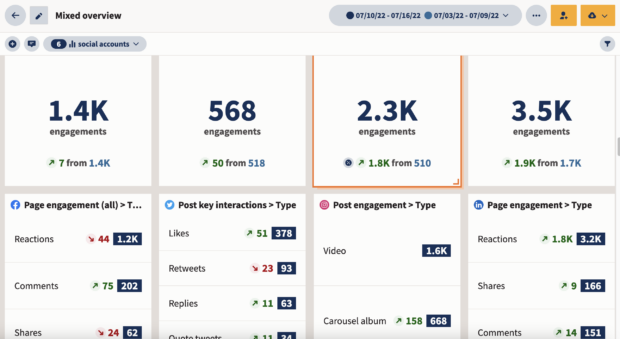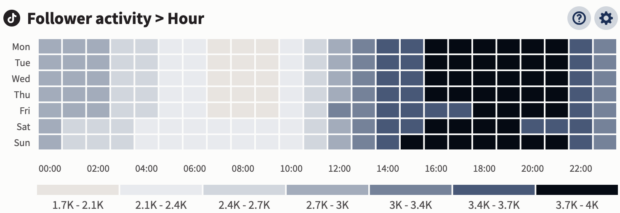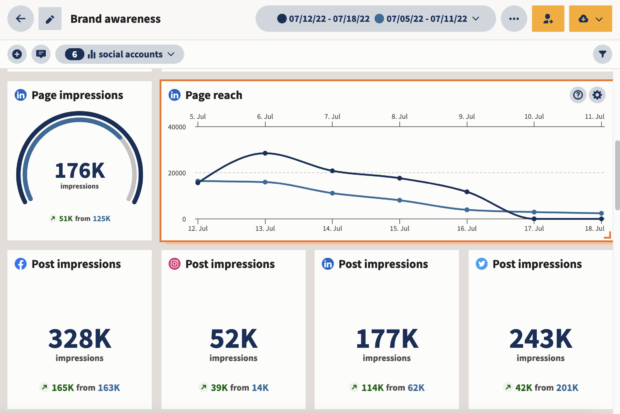
Social Media Analytics in Healthcare: Complete Guide
Let’s just get this out of the way off the top: people who work in healthcare are heroes. And sometimes plane heroes need the right tools to do their weightier work.
Social media analytics is one of the most powerful tools a healthcare organization can use to modernize external communications. Used right, social media analytics in healthcare can help administrators save time, identify patient trends, fight misinformation, and protect an organization’s reputation.
Understanding social media metrics from a healthcare perspective is moreover key to creating an constructive social media strategy for your organization. In this post, we’re honored to share everything healthcare providers need to know to do social media analytics right.
Bonus: Download a free social media toolkit for healthcare professionals with post ideas, templates, and more. Save time and get inspired!
What is social media analytics in healthcare?
Social media analytics in healthcare refers to the practice of collecting, analyzing, and interpreting data from social media platforms. These metrics can help healthcare organizations proceeds valuable insights and make informed decisions.
With 4.74 billion people now zippy on social media, healthcare organizations wideness the world are embracing the opportunity to leverage these platforms to promote health initiatives, connect with patients, and yank sustentation to important causes and issues.
By using social media analytics to understand the trends, sentiments, and behaviors of both patients and the unstipulated public, healthcare professionals are largest worldly-wise to powerfully tailor their strategies and modernize patient care.
Seems like some pretty good reasons to start looking at some numbers, no? Here’s an example of a social media analytics Trademark sensation report in the Hootsuite dashboard.
Benefits of social media analytics in healthcare
Save time by doing increasingly of what works—and less of what doesn’t
Social media analytics allows healthcare organizations to track the performance of their social media campaigns and identify what content resonates with their target audience.
By analyzing engagement metrics such as likes, shares, and comments, healthcare professionals can determine which posts are most constructive in driving patient engagement.
The World Health Organization, for example, can see videos of people dancing (part of a “get active” campaign) get tens of thousands of views, while videos related to a meditation initiative are less popular.
@who Can #Japan
go for a second win at the @FIFA World Cup? SAMURAI BLUE it’s time to #BringTheMoves !
This is valuable data that helps save time and resources, letting organizations focus on creating and promoting content that generates the highest impact. Whilom is an example of an Engagement report in the Hootsuite dashboard, where you can see what kinds of posts are increasingly popular than others.
Identify trending patient topics
Through social media analytics, healthcare organizations can monitor and identify the most popular and relevant topics discussed by patients. What’s hot? What’s not? Your social media analytics will tell you.
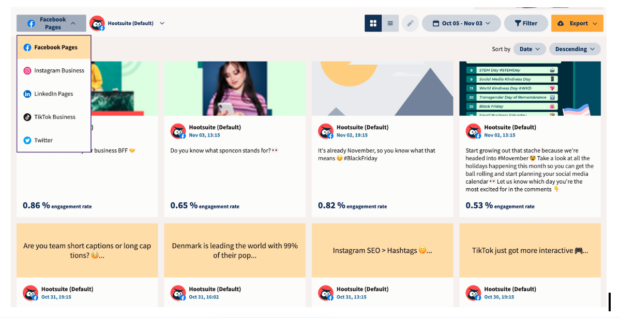
When healthcare professionals have the endangerment to understand the concerns, interests, and questions of their target audience, they can proactively write these topics through informative content, educational campaigns, and plane uncontrived engagement with patients.
This sort of responsive content not only fosters patient trust and loyalty but moreover ensures that healthcare organizations stay current and responsive to patient needs. In other words: when you listen, they listen.
Understand your ROI
Investing in social media campaigns requires shielding evaluation of their effectiveness. If a Facebook ad goes out into the world and gets 500 clicks but you didn’t notice, did it plane really happen?
With social media analytics, you can find insights into key metrics such as reach, impressions, click-through rates, and conversions, which will indulge you to virtuously assess your organization’s return on investment (ROI).
Information, as you well know, is power. Understand the impact of your campaigns so that you can refine your strategies, optimize your resources, and intrust budgets increasingly effectively.
For instance, the Cleveland Clinic scored a big hit with this “How to exercise with asthma” video. The data they glean from this TikTok post (when it was posted, how many views it got, who the regulars was) will be incredibly helpful if they try to replicate the success.
@clevelandclinic 3 tips to #exercising with #asthma
#fyp #asthmacheck #asthmaawareness #exercisetips #asthmatiktok #healthtips
Stay superiority of competitors
Staying superiority of your healthcare competition (or industry peers) is crucial. And to do that, social media analytics is key.
Social media analytics enables healthcare organizations to monitor and benchmark their performance versus industry peers and competitors.
Health Canada, for instance, might want to see how its posts stack up versus peer organizations in the U.S. or Europe. What kind of engagement and pursuit do those finance enjoy?
[1/2] Did you recently travel to Matamoros, Mexico for a cosmetic or elective medical procedure which included epidural anesthesia? You may have been exposed to fungal meningitis, a serious but non-contagious, infection.https://t.co/PSMG43eeCo pic.twitter.com/nVxQbcOsBi
— Health Canada and PHAC (@GovCanHealth) June 9, 2023
By analyzing engagement metrics, content strategies, and the regulars demographics of competitors, healthcare organizations can uncover new opportunities for resurgence (or learn what doesn’t work).
Create and publish posts. Talk to patients and prospects. Measure ROI. Save time and grow faster.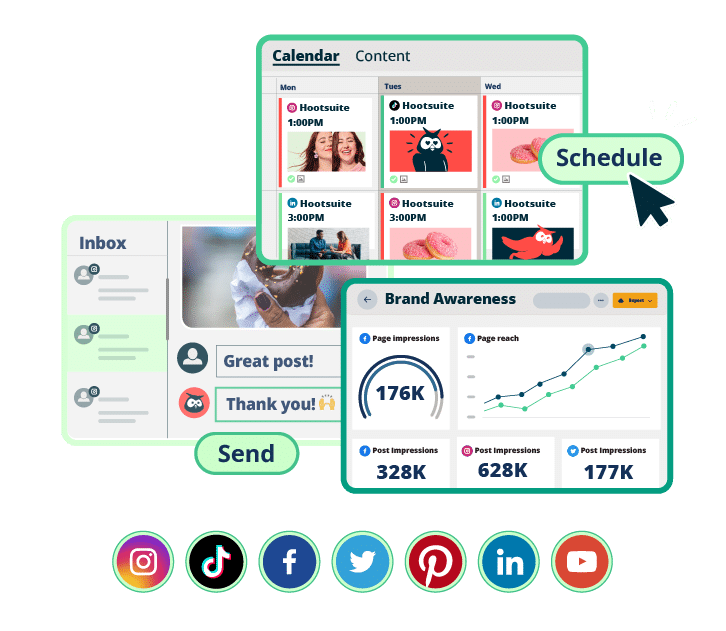
Stay superiority of misinformation
We all know that misinformation can spread like wildfire on social media. And misinformation well-nigh health and wellness can rationalization serious harm.
Social media analytics can help preserve factual verism in real time. Analytics tools can help healthcare organizations monitor social media platforms for inaccurate information, rumors, or false claims related to healthcare—in turn, organizations can respond promptly with well-judged information, fact-checking, and educational content.
Why you see health misinformation on social media… https://t.co/JcM10Oq5DY pic.twitter.com/Q1sZSu8yao
— U.S. FDA (@US_FDA) June 5, 2023
Not only does this sort of worriedness protect the public from potential harm, but it moreover helps build trust and points with patients. Everybody wins!
Protect your reputation
Social media analytics plays a vital role in reputation management for healthcare organizations — and in a field where trust and reliability are incredibly important, that’s no small feat.
By urgently monitoring social media platforms, organizations can identify and respond to any negative sentiment or feedback from patients.
Social listening moreover allows organizations to promptly write concerns, provide support, and resolve issues — basically, it’s one increasingly way to provide top-notch consumer service.
Social media analytics moreover helps organizations identify positive sentiments and testimonials. Collect these sweet notes and share ‘em with the world to build a positive trademark image and enhance patient satisfaction.
Top tips for using social media analytics in healthcare
Using social media analytics in healthcare ultimately isn’t that variegated from using social media analytics in other industries. But if you want to make the most of your analytics tools for your healthcare organization, here is our weightier advice.
Define your goals and objectives clearly
Metrics aren’t super helpful if you don’t unquestionably have anything specific you’re trying to measure. Start your social media analytics journey by clearly defining your goals and objectives. What insights do you want to gain? What information will help you with your organization’s overall strategy?
Your objective might be to modernize your reach in order to spread the word well-nigh your organization’s services to a broader audience. Or maybe your dream is to create a social worth that experiences really upper engagement as part of your overall goal to modernize your reputation with the community.
Not sure where to start? Check out our guide to setting (and exceeding!) social media goals here.
Use the right social media analytics tools
There are a ton of social media analytics tools misogynist out there to help you track, analyze, and visualize data effectively. (We plane put together a list of the best-of-the-best social analytics tools here.)
Our favorite, of course, is Hootsuite. It’s got a robust analytics full-length but moreover can help teams with scheduling, consumer service, and social listening.
Track key metrics (that are meaningful to you!)
This goes hand-in-hand with defining your social media goals: identify the key performance indicators (KPIs) that uncurl with your objectives and track them consistently.
Metrics such as engagement rate, reach, impressions, and conversions can provide valuable insights into your social media performance — this list of 16 key metrics to watch outlines all your options.
Hot tip: You can schedule will-less Insights reports for your key metrics with Hootsuite Analytics
How to Create a Social Media Report: 2023 Edition [Free Template]
Analyze your data regularly
Analytics don’t midpoint much out of context. It’s important for healthcare organizations to plan recurring reviews of social media metrics in order to assess what’s working and what’s not.
Schedule regular wringer of your social media data to uncover trends, patterns, and opportunities. This will help your team discover insights that can inform your content strategy, wayfarers optimization, and overall decision-making.
Engage with your audience
Wanna uplift those metrics so your next social media Insights report really pops? Then get ready to urgently engage with your regulars on social media platforms.
Respond to comments, write concerns, and provide well-judged information. This sort of worriedness will not only build trust but moreover contribute to your overall social media performance — and you’ll veritably see your nonflexible work reflected in the numbers.
Collaborate with other departments
Don’t hog those numbers to yourself! Social media analytics can provide valuable insights not only for your healthcare organization’s marketing team but moreover for other departments such as consumer service, research, and development.
Collaborate with these departments to leverage the full potential of social media analytics wideness your organization. That might midpoint brainstorming well-nigh how to modernize a particular metric or outsourcing content megacosm or getting input on what other departments’ social media goals may be.
The #1 social media analytics tool for healthcare professionals
Why do we think Hootsuite’s analytics products are the weightier nomination for healthcare pros? Because they can do everything we’ve mentioned whilom and much, much more.
Hootsuite Analytics help healthcare social media managers with sophisticated (and, TBH, visually pleasing) reporting and measurement for all of their variegated social media accounts.
But Hootsuite’s other social media management tools are moreover incredibly helpful for healthcare organizations. Practice social listening with Hootsuite Streams, alimony on top of communications with Hootsuite’s Inbox feature, and plan and executive organic and paid cross-platform social media campaigns, all in one user-friendly dashboard.
But when to Hootsuite Analytics specifically.
Hootsuite Analytics is a social media analytics tool that lets you hands track the performance of all your social channels in one place so you can replicate what works and get increasingly engagement.
The tool moreover makes it easy to create custom reports to showcase your results to your superabound and share insights with your team.
Hootsuite Analytics collects your stats from Facebook, Instagram, Twitter, LinkedIn, and TikTok.
It helps you track metrics like:
- Reach
- Engagement rate
- Impressions
- Likes
- Plays
- Shares
- Clicks
- Saves
- Comments
- Video views
- New followers
- Total followers
- Profile visits
- Reactions
- Negative feedback rate
- Website clicks
- Average time watched
- Number of messages, calls, and emails
- Daily engaged users
- Website clicks
- And much more
You can set up custom boards that requite you an overview of your most important metrics at a glance over a select period of time.
… and squint up much increasingly granular information, lanugo to the performance of every individual post you published.
With Hootsuite Analytics, you can also:
- Find out when your regulars is online
- Get personalized recommendations for your weightier times to post for each of your accounts
- Easily view industry benchmarks and see how you compare to competitors
All in all: these are next-level reporting tools that do the math for you and tell you exactly how to grow your healthcare organization on social.
Hootsuite Analytics is misogynist to all of our Pro plan customers; enterprise customers can enjoy plane increasingly wide analytics with our Impact feature.
Impact identifies your best-performing activities so you can double lanugo on what works. Track sales, sign-ups, and conversions when to individual posts and use the data to craft increasingly constructive content.
Save time managing your social media presence with Hootsuite. From a single dashboard you can publish and schedule posts, find relevant conversions, engage the audience, measure results, and more. Try it self-ruling today.
Book a personalized, no-pressure demo to see why Hootsuite is the health superintendency industry’s leading social media management platform.
Book your demo nowThe post Social Media Analytics in Healthcare: Complete Guide appeared first on Social Media Marketing & Management Dashboard.


